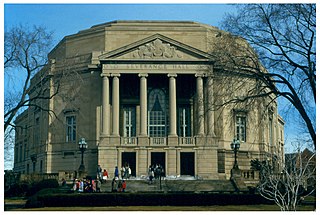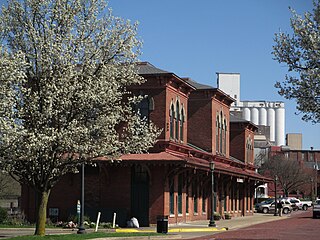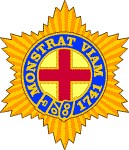
New Philadelphia is a city in and the county seat of Tuscarawas County, Ohio, United States. The county's largest city, New Philadelphia lies along the Tuscarawas River. The population was 17,677 at the 2020 census. It is a principal city in the New Philadelphia–Dover micropolitan area, approximately 71 miles (114 km) south of Cleveland.

Jeptha Homer Wade was an American industrialist, philanthropist, and one of the founding members of Western Union Telegraph. Wade was born in Romulus, New York, the youngest of nine children of Jeptha and Sarah (Allen) Wade. He made the first Daguerreotypes west of New York, was a portrait painter, and moved to Adrian, Michigan in 1840 before developing an interest in the telegraph.

Severance Hall (newly named Severance Music Center) is a concert hall and the home of the Cleveland Orchestra in the University Circle section of Cleveland, Ohio. Opened in 1931 to give the orchestra a permanent home, the building is named for patrons John L. Severance and his wife, Elisabeth Huntingdon DeWitt Severance. It is listed on the National Register of Historic Places as part of Cleveland’s Wade Park District.

The Warner Theatre is an Art Deco and French Renaissance-styled theater located in downtown Erie, Pennsylvania in the United States. It was listed on the National Register of Historic Places in 1982. The Warner was designed by Chicago-architects Rapp and Rapp and was opened in 1931. It was used as a movie theater until 1976, when it was sold to the City of Erie. In the early 1980s, Erie converted the theater to a performing arts center, which has become the focus of a downtown revival.

The Agora Theatre and Ballroom is a music venue located in Cleveland, Ohio, founded by Henry "Hank" LoConti Sr. The Agora name was used by two other Cleveland venues in succession, the latter of which was damaged by fire in 1984. The current Agora venue, known as such since 1986, first opened in 1913 as the Metropolitan Theatre.

The Massachusetts National Guard is the National Guard component for the Commonwealth of Massachusetts. Founded as the Massachusetts Bay Colonial Militia on December 13, 1636, it contains the oldest units in the United States Army. What is today's Massachusetts National Guard evolved through many different forms. Originally founded as a defensive militia for Puritan colonists in the Massachusetts Bay Colony, the militia evolved into a highly organized and armed fighting force. The Massachusetts militia served as a central organ of the New England revolutionary fighting force during the early American Revolution and a major component in the Continental Army under George Washington.

The Ohio National Guard comprises the Ohio Army National Guard and the Ohio Air National Guard. The commander-in-chief of the Ohio Army National Guard is the governor of the U.S. state of Ohio. If the Ohio Army National Guard is called to federal service, then the President of the United States becomes the commander-in-chief. The military commander of all forces in the State of Ohio is the Adjutant General, Major General John C. Harris, Jr. is responsible for the command of 17,000 members, preparedness and readiness, installation management, and budget of the Ohio National Guard. The current Assistant Adjutant General for Army, with responsibility for overseeing the Ohio Army National Guard training and operations, is Brigadier General Thomas E. Moore II. The current Assistant Adjutant General for Air is Major General James R. Camp with responsibility for overseeing the Ohio Air National Guard.

The Ohio Army National Guard is a part of the Ohio National Guard and the Army National Guard of the United States Army. It is also a component of the organized militia of the state of Ohio, which also includes the Ohio Naval Militia, the Ohio Military Reserve and the Ohio Air National Guard. The Ohio Army National Guard consists of a variety of combat, combat support, and combat service support units. As of September 2010, its end strength exceeded 11,400 soldiers. Its headquarters is the Beightler Armory in Columbus, Ohio. Many units conduct Annual Training at Camp Grayling, Michigan.

The Newport Artillery Company of Newport, Rhode Island was chartered in 1741 by the Rhode Island General Assembly during the reign of King George II of Great Britain. It is the oldest military unit in the United States operating under its original charter, and the company maintains a museum in its historic armory. The company has served in wars ranging from the French and Indian War to the First World War. Individual members of the Company have served in every war fought by the United States.

The Armory of the Kentish Guards is a historic armory at Armory and Peirce Streets in East Greenwich, Rhode Island and is currently home to the Kentish Guards, a historic Rhode Island Independent Military Organization.

Worthy Stevens Streator was an American physician, railroad developer, industrialist and entrepreneur after whom the city of Streator, Illinois, is named. He was instrumental in the creation of the Atlantic and Great Western Railway in Ohio, was president of the Baltimore and Ohio Railroad (B&O), and financed the first large-scale coal mine operation in Northern Illinois in 1866. He served as an Ohio State Senator in 1869, and was the first mayor of East Cleveland, Ohio. He was an influential in the development of many civic institutions in his home city of Cleveland, Ohio. He co-founded the Christian Standard magazine, he was an original endower of Case School of Applied Science and was a principal in the creation of the James A. Garfield Monument; the first true mausoleum created in the United States in honor of President James A. Garfield. He was a pallbearer at President Garfield's funeral in 1881.

Kent is a city in the U.S. state of Ohio and the largest city in Portage County. It is located along the Cuyahoga River in Northeast Ohio on the western edge of the county. The population was 28,215 at the 2020 Census. The city is counted as part of the Akron metropolitan area and the larger Cleveland–Akron–Canton combined statistical area.

The Hoosick Falls Armory is located along Church Street in Hoosick Falls, New York, United States. It is a red brick building with castellated tower dating to the late 19th century.

George Francis Hammond was an architect in Cleveland, Ohio, United States, who designed commercial buildings, hotels, schools, churches, residences, and the plans for Kent State University's layout and original buildings. His work is mostly Neoclassical architecture, including in the Beaux Arts Architecture style, and includes an example of Egyptian Revival architecture in the basement foyer of the Hollenden Hotel.

The 211th Military Police Battalion is a unit of the Massachusetts Army National Guard. Its Headquarters and Headquarters Detachment is descended from the First Corps of Cadets, initially formed in 1741. It is one of several National Guard units with colonial roots. Its motto is Monstrat Viam – "It Points the Way." While it has served in five wars, the sub-unit's primary contribution to Massachusetts and to the United States was as an officer-producing institution for new regiments from the Revolutionary War through World War II.

The First Corps of Cadets of Massachusetts formed in 1741. Its motto is Monstrat Viam - "It Points the Way." While it has served in several wars, the sub-unit's primary contribution to Massachusetts and to the United States was as an officer-producing institution for new regiments from the Revolutionary War through World War II.
The Cleveland Landmarks Commission is responsible for determining whether buildings, sites or historic districts are eligible for designation as landmarks in the city of Cleveland, Ohio. As Cleveland has many historic streets, districts, and buildings the commission is charged with weeding out what buildings, districts, and streets are of definite interest to the people of Cleveland, Ohio and the nation of the United States in general. Two of the oldest buildings in the city that are listed on the Landmarks Commission are the 1824 Dunham Tavern Museum and the 1855 Old Stone Church located on Public Square.

The Montgomery Guards were an Irish-American militia company that formed in Boston in 1837 and were forced to disband the following year due to extreme nativist and anti-Catholic sentiment in the city.

The United States Zouave Cadets was a short-lived zouave unit of the Illinois militia that has been credited as the force behind the surge in popularity of zouave infantry in the United States and Confederate States in the mid-19th century. The United States Zouave Cadets were formed by Elmer Ellsworth in 1859 from the National Guard Cadets of Chicago, established three years earlier. The unit's 1860 tour of the eastern United States popularized the distinctive zouave appearance and customs, directly and indirectly inspiring the formation of dozens of similar units on the eve of the American Civil War.

The following is a bibliography of Cleveland, Ohio. It includes selected publications specifically about the city, Cuyahoga County, and the Greater Cleveland Metropolitan Area.























